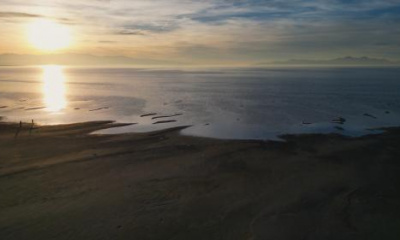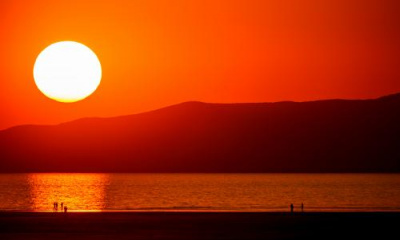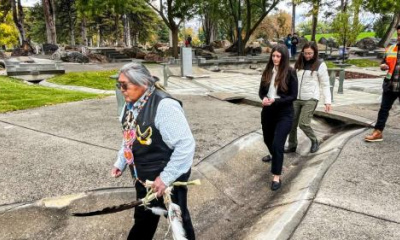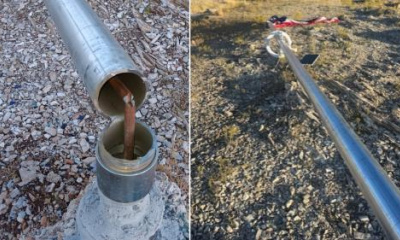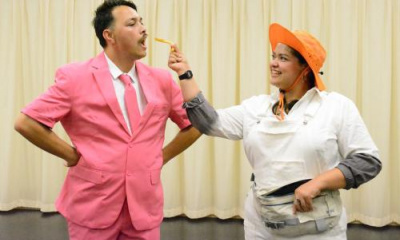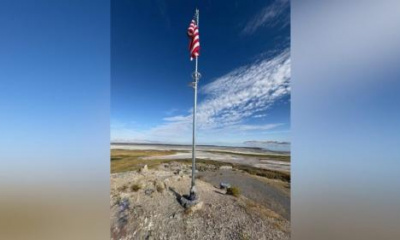FARMINGTON — A new mural being painted at the Eccles Wildlife Education Center in Farmington will represent the connection between three ecosystems sustaining migrating birds around the world.
Franco Cervato Cozza, also known as Vato, is a mural artist from Cordoba, Argentina. Cozza painted his first of the three connected murals at an education center outside Mar Chiquita Lake in Argentina, a salt lake where migration begins for phalaropes and other birds.
He painted his second mural at Mono Lake, a salt lake in Mono County, California, before coming to the Eccles Wildlife Education Center at the Robert N. Hasenyager Great Salt Lake Nature Reserve.
Cozza said he's doing this because its important for the United States and Argentina to work together in preserving these ecosystems that allow so many birds to thrive.
"It's amazing to be the person that can paint that, and to help people learn about this, because a lot of people here and in Argentina don't know about phalaropes," Cozza said. "It's good for people to notice, so we can make some changes."
Ashley Kijowski, Eccles Wildlife Education Center coordinator, said when Utahns conserve water or help to preserve local ecosystems, they are also helping other communities.
"It's connecting birds all the way from South America to here. Not only do we have to take care of our environment here locally, but just think about how that affects birds in other places," Kijowski said. "What we do here can help the Great Salt Lake, but it's going to help all these other places, too, and connect us everywhere."
Kijowski said many people see the Great Salt Lake as dead because of all the salt, but "it's so alive" and full of creatures — like brine shrimp and brine flies — for birds to eat. Twelve million birds rely on the Great Salt Lake every year.
Kijowski hopes the mural will help Utahns see the importance of the Great Salt Lake.
"I just want the public to come in here and not only be amazed by his artwork and have it be kind of a magical place, but also learn about the importance of the ecosystem to wildlife," Kijowski said. "These birds are coming here from 3,000 miles away, so it must be important."
A collaborative process
Most of Cozza's murals are in Argentina. He has painted them for about 10 years, finishing around 50 murals each year. Kijowski said this is his first to go off-sketch, as she has guided him through including each important local species she wants to highlight.
"It's way better than I could ever have imagined," Kijowski said.
Kijowski has projected images taken by local wildlife photographer and center volunteer Brandon Jones onto the wall, which Cozza then sketches in.
Along with representing a greater collaborative effort between Argentina and the United States, Kijowski said the mural has received a lot of local collaboration. The Audubon Saline Lakes Program paid for Cozza's hotel while he stays in Utah, and the Division of Wildlife prepared the wall to be painted. The sixth grade class at Emerson Elementary School who helped brine shrimp become the state crustacean also made T-shirts to raise money to pay Cozza for his service.
"It's been really collaborative," Kijowski said. "It's been great to see how much everyone cares."
The mural was started on Wednesday and will take around eight to nine days to complete.
Education center resources
The Eccles Wildlife Education Center's mission is to teach people about the Great Salt Lake and how to take care of it. Kijowski invites Utahns to come to the center to see the mural and learn more about the Great Salt Lake ecosystem.
The center includes a 1.2 mile walkway through the wetlands, another trail to a blue heron rookery (nesting platform), monthly bird-watching walks, a kids' summer education program and quarterly educational seminars. People interested in visiting the center can find more information on their Facebook page.


